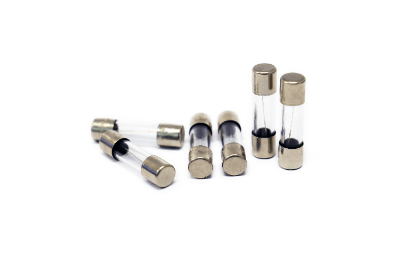What Is a Fuse?
 A fuse is an electrical/electronic component that prevents electrical fire or spillover to upper circuits in the event of an overcurrent.
A fuse is an electrical/electronic component that prevents electrical fire or spillover to upper circuits in the event of an overcurrent.
When an abnormality such as a short circuit or overload occurs in an electric circuit, an overcurrent occurs, in which the current value exceeds the designed value of the circuit. Overcurrents not only lead to failure of the equipment itself on the electric circuit, but can also cause fires due to abnormal heat generation or ignition.
There is also a high risk of voltage drops and other abnormalities occurring in the upper circuits on the power supply side. Fuses are incorporated to protect against these hazards from overcurrents. When connected in series with a circuit, they act as conductors that carry current during normal operation. When an overcurrent occurs, the conductor in the fuse melts, thereby interrupting the power supply to the load-side circuit.
Uses of Fuses
Fuses are used in a wide range of applications in industry.
Specific applications are as follows:
- For protection of instrumentation and control circuits
- For protection of automotive control parts
- For protection of OA equipment such as printers and multifunctional machines
- Protection for white goods such as TVs and air conditioners
- Short-circuit protection for transformers in high-voltage power transmission and distribution networks
- Short-circuit protection for high-voltage motors
In the past, no-fuse breakers were used in many home switchboards, but in recent years, no-fuse breakers have become more popular than fuses, which need to be replaced once they blow.
However, Fuses are still used in automobiles to protect electrical systems and prevent vehicle fires. They come in a variety of shapes depending on their application and include plate fuses and blade-type fuses.
Principle of Fuses
The basic principle of a fuse is that it self-blows due to heat generated by an overcurrent. Fuses are mainly composed of a mouthpiece, fuse element, and housing.
1. Mouthpiece
The mouthpiece is the metal part that connects the fuse to the electrical circuit. Fuses with Y-terminals or blade type fuses are also available.
2. Fuse Element
The fuse element is the part of the fuse that melts in the event of an overcurrent. When current flows through the fuse element, Joule heat proportional to the square of the current value is generated. If the current is less than the rated current, heat dissipation is superior to the temperature rise associated with the Joule heat generation, so fusing does not occur. When the rated current is exceeded, the temperature rises and the current is cut off by melting. In general, the fuse is irreversible and must be replaced before it can be restored to its original state.
3. Housing
The housing is the part that supports the element and mouthpiece of the fuse. It is made of insulating materials such as glass, porcelain, or resin. Fuses whose housings are made of glass tubing are called glass-tube fuses.
How to Select a Fuse
Fuses are selected primarily by their ampere rating. The key point is to select a fuse with a rated current that is less than or equal to the rated current value of the components on the circuit, while ensuring that there is no circuit breakage due to malfunction.
Currents to be considered in selection include steady-state current and inrush current. The steady-state current is the current value that flows when the circuit actually used is stable, while the inrush current is the high starting current that occurs when the power is turned on to the circuit. The inrush current does not cause the device to melt, but it is selected so that it will melt when the inrush current exceeds the steady-state current during steady-state operation. The protection conditions are examined by combining the breakdown-time characteristic and the rated current.
The melt-time characteristic is the characteristic of the magnitude of the current and the time it takes to be interrupted. The inrush current is selected so that the device will not melt during the duration of the inrush current and will melt immediately in the event of a short-circuit accident. Another important item to consider when selecting fuses is the ambient temperature, where the circuit will actually be used. Fuses are designed to blow due to heat, so they are affected by the ambient temperature of the area around the equipment.
Types of Fuses
Fuses come in a variety of shapes and sizes to suit the type of circuit and environment in which they are mounted.
Typical types are as follows:
- Fuses for mounting on electronic circuit boards
- Thermal Fuses
- Glass-tube Fuses
- Blade fuses
- Current-limiting Fuses for high-voltage circuits
If the type or shape of a fuse you want to use is not available in the off-the-shelf products, some manufacturers will accept special orders. Most fuses are power fuses that interrupt at overcurrent, but there are also thermal fuses that interrupt at temperature.
Because they detect a rise in ambient temperature and blow, they are often used in appliances that generate heat, such as hair dryers. The elements of thermal cutoffs have low resistance and generate almost no heat due to the current.